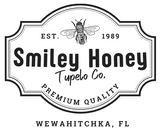ACACIA HONEY IS LIGHT AND WONDERFUL
Trees Have More Flowers
For honey production, nothing beats a flowering tree. A horizontal field of flowers offers honeybees just one level of nectar foraging. But flowering trees give far more nectar per acre, as they provide multiple, vertical levels of honeybee heaven.
One notable nectar powerhouse is the acacia tree. (Pronounced "Ah-KAY-sha")
The scientific name for this tree is robinia psuedoacacia, from which comes the common name of "acacia" (or sometimes "false acacia"). But in the United States, this tree is typically called a "black locust" tree.
Strong Trees and Fast Growth
The tree is native to the Eastern United States. It was first identified in 1607 by colonists in Jamestown, who quickly learned that the strong trees made great timber for building houses. By 1636, black locust trees were shipped back to England, and then carried into other parts of Europe. Mature black locust trees can grow to 80 feet in height, but 30 to 50 feet tall is more typical. These trees reproduce in two ways, allowing them to spread rapidly. Fertilized flowers develop into smooth, pea-like pods. When the pods dry and split open, seeds are released.
Acacia Forests
The trees also produce root suckers, which then grow out and up as new trees. Once several trees get established, these suckers will produce colonies of trees that crowd out all other species. This results in entire forests of acacia trees.
One area where acacia forests are plentiful is Eastern Europe - specifically Romania, Hungary and Ukraine. Because of their reputation for fast growth and hard wood, acacia trees were planted for forest land reclamation after the existing trees had been harvested. Today, in Romania alone, there are over 600,000 acres of acacia forests on both public and private lands.
Sweet Flowers Make Sweet Honey
Acacia tree blossoms are very fragrant. So much so that some cannot resist eating them right off the tree. In southern France, they dip fresh flower clusters in a light batter and fry them to make beignets. Another French culinary creation infuses the flowers into a vanilla creme anglaise to make acacia flower ice cream. If you want to practice your French and learn the recipes, check out this beignet video or this ice cream video.
Honeybees are also very strongly attracted to the sweet smells of acacia flowers.
Acacia trees generally bloom for 7 to 10 days sometime in late May or early June, depending on the local climate. Bees work rapidly to collect the abundant nectar and carry it back to the hive to turn it into honey.
Acacia honey is one of the lightest colored honey varieties that you can find in the world. In some years, it will grade as "water white" and is so clear you can read a newspaper through the jar. But "extra white" is also a common color of this honey. This wonderful color makes acacia honey a prized variety.
What Does Acacia Honey Taste Like?
The flavor of this honey is medium sweet and very mild. It has just a whisper of vanilla flavor, and almost no aftertaste.
Due to a high fructose content, this special honey also resists sugaring, and should remain liquid for a long time (assuming you can resist not eating it all in a month or two).
